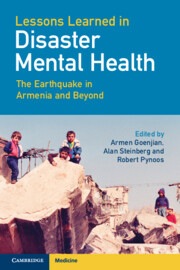Book contents
- Lessons Learned in Disaster Mental Health: The Earthquake in Armenia and Beyond
- Frontispiece
- Lessons Learned in Disaster Mental Health: The Earthquake in Armenia and Beyond
- Copyright page
- Contents
- Dedication
- Preface
- Contributors
- Chapter 1 The 1988 Spitak Earthquake in Armenia and the Implementation of the Psychiatric Outreach Program
- Chapter 2 Diaspora Therapists Working in the Earthquake Zone
- Chapter 3 Treatment Outcome among Early Adolescents Two Decades Post-Earthquake
- Chapter 4 Course and Predictors of PTSD and Depression among Not Treated Children and Adolescents over Two Decades
- Chapter 5 Conscience, Moral Injury, and Psychopathology
- Chapter 6 Natural Disasters and Relocation
- Chapter 7 Long-Term Course of PTSD and Depression Among Adults, Mediating and Moderating Factors in Recovery, and Current Trends for Treatment
- Chapter 8 How the Spitak Earthquake Contributed to our Understanding of the Genetics of PTSD and Associated Disorders
- Chapter 9 Epidemiology of Disasters and the Spitak Earthquake
- Chapter 10 Traumatic Stress Conceptual Framework
- Chapter 11 Memoirs of the Spitak Earthquake
- Chapter 12 Lessons Learned from the Spitak Earthquake and Other Catastrophic Disasters
- Index
- Plate Section (PDF Only)
- References
Chapter 6 - Natural Disasters and Relocation
Published online by Cambridge University Press: 20 May 2022
- Lessons Learned in Disaster Mental Health: The Earthquake in Armenia and Beyond
- Frontispiece
- Lessons Learned in Disaster Mental Health: The Earthquake in Armenia and Beyond
- Copyright page
- Contents
- Dedication
- Preface
- Contributors
- Chapter 1 The 1988 Spitak Earthquake in Armenia and the Implementation of the Psychiatric Outreach Program
- Chapter 2 Diaspora Therapists Working in the Earthquake Zone
- Chapter 3 Treatment Outcome among Early Adolescents Two Decades Post-Earthquake
- Chapter 4 Course and Predictors of PTSD and Depression among Not Treated Children and Adolescents over Two Decades
- Chapter 5 Conscience, Moral Injury, and Psychopathology
- Chapter 6 Natural Disasters and Relocation
- Chapter 7 Long-Term Course of PTSD and Depression Among Adults, Mediating and Moderating Factors in Recovery, and Current Trends for Treatment
- Chapter 8 How the Spitak Earthquake Contributed to our Understanding of the Genetics of PTSD and Associated Disorders
- Chapter 9 Epidemiology of Disasters and the Spitak Earthquake
- Chapter 10 Traumatic Stress Conceptual Framework
- Chapter 11 Memoirs of the Spitak Earthquake
- Chapter 12 Lessons Learned from the Spitak Earthquake and Other Catastrophic Disasters
- Index
- Plate Section (PDF Only)
- References
Summary
Relocation of residents to a safer location may be necessary when homes are destroyed during a natural disaster. Relocation involves economic hardship and separation from one’s community, where support systems and safety networks are established. These changes compound stress reactions to the trauma of the disaster, such as post-traumatic stress disorder (PTSD), depression, and anxiety. This chapter reviews our work in Armenia and the work of others who studied the effects of relocation on stress reactions after natural disasters worldwide. It also describes variables involved with relocation which potentially impact the severity of stress reactions, such as degree of exposure to the disaster, timing, duration and the place of relocation (within or outside the city) and the extent of losses (including the life of family members, home, employment, and social support) necessitating relocation. The general consensus is that relocation contributes to the emotional sequelae of a disaster. The studies describe factors that minimize the impact of relocation to stress reactions. A consistent mitigating factor is emotional support. Recommendations for future research are included in this chapter for a better understanding of the effect of variables involved with relocation on stress reaction.
- Type
- Chapter
- Information
- Lessons Learned in Disaster Mental HealthThe Earthquake in Armenia and Beyond, pp. 97 - 110Publisher: Cambridge University PressPrint publication year: 2022



